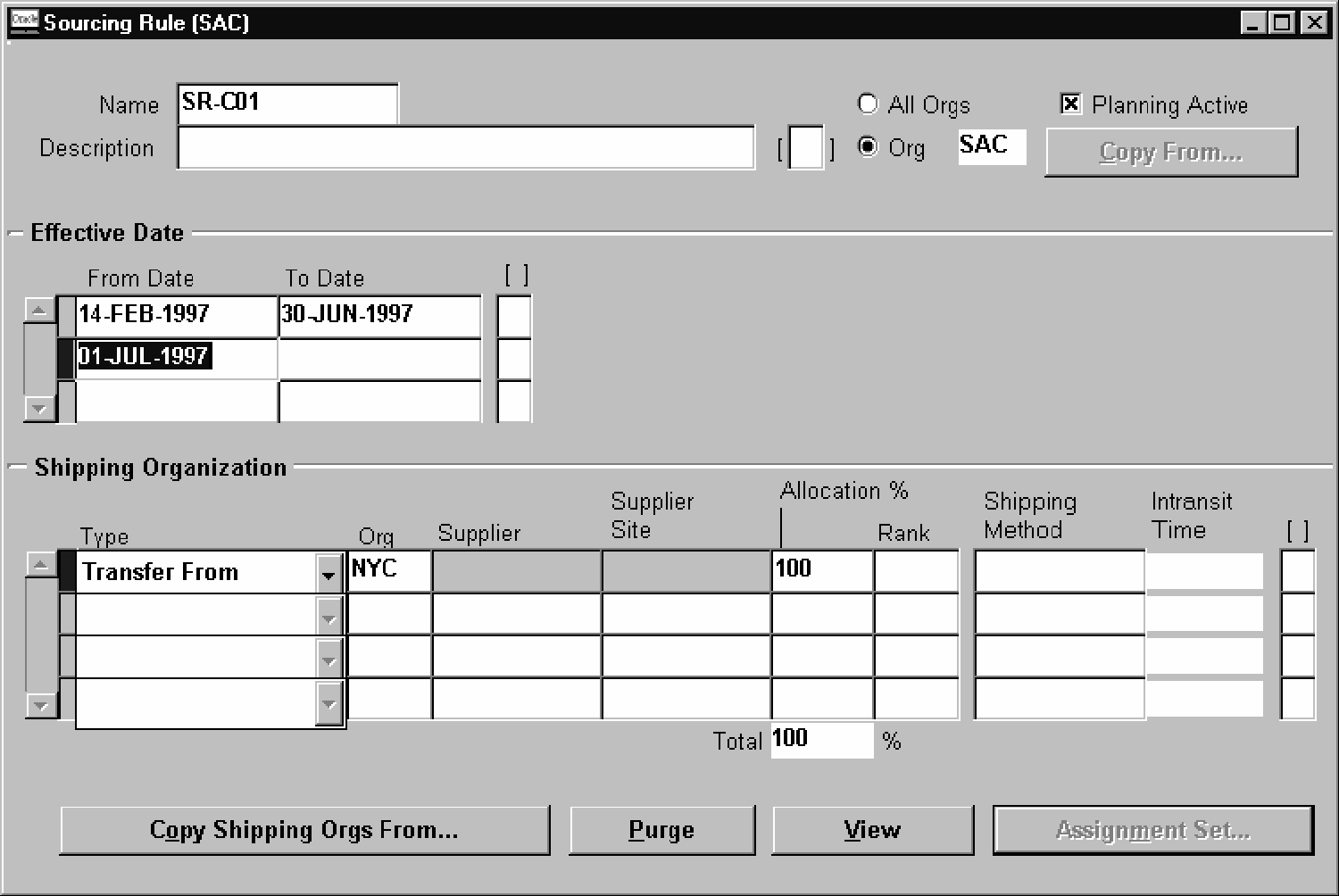| Previous | Next | Contents | Index | Navigation | Glossary | Library |
Oracle Supply Chain Planning minimizes the effort required to set up, implement, and maintain this strategy with sourcing rules and bills of distribution.
Sourcing rules and bills of distribution both specify date-effective sourcing strategies, combining replenishment sources with split allocation percentages and rankings. A replenishment source is:
Rank and Allocation You can rank the sources of supply named in the rules and bills, giving one priority over another when the planning process generates recommendations. You can also assign sourcing percentages to these sources, allowing you to allocate a portion of the total orders to each source.
Control over Make/Buy Attributes In Oracle Master Scheduling/MRP, three item attributes determine if planned orders can be implemented as discrete jobs, repetitive schedules, or purchase requisitions. Supply Chain Planning users can supplement and refine this behavior with sourcing rules and bills of distribution.
For each item in a rule or bill, you can define effectivity dates to switch sourcing between make and buy, and set intransit lead times. If an item does not appear in a rule or bill, the item attribute determines the status; when these attributes conflict with a sourcing rule or bill of distribution, the rule or bill takes precedence. (See: Item and Bill of Material Attributes, and Defining Items.)

In the first phase of SR-C01, SAC is replenished equally by AUS and NYC. From 01-JUL-1997, AUS no longer supplies SAC, which receives all transfers from NYC:

This sourcing rule can apply to one org (SAC, in this example), or to all your organizations. However, you cannot choose a single organization in one phase and all organizations in another phase. That would require two sourcing rules, with consecutive effectivity dates. If you assign the sourcing rule to one receiving organization (SAC in this example), it is a local sourcing rule; if you assign it to multiple organizations, it is a global sourcing rule.
You cannot apply sourcing rules and bills of distribution (make them Planning Active) until the sum of the allocation percentages equals 100. Secondly, sourcing rules and bills of distribution do not take effect until they are assigned to a part or a range of parts. (See: Assigning Sourcing Rules and Bills of Distribution.)
In another example, an item is made in a manufacturing center and supplied to a distribution center, which in turn supplies three sales offices. Instead of using five different local sourcing rules, you could set up a three-level replenishment hierarchy with a bill of distribution for the item. This bill would specify how the item is sourced at each level.
Both sourcing rules and bills of distribution have effective dates, periods during which the scheme is valid. For each period, you can specify a list of sources, type, allocation percentage, rank, shipping method, and intransit time.
You cannot apply sourcing rules and bills of distribution (make them Planning Active) until the sum of the allocation percentages equals 100. Secondly, sourcing rules and bills of distribution do not take effect until they are assigned to a part or a range of parts. (See: Assigning Sourcing Rules and Bills of Distribution.)

Sourcing rule SR-C02 describes the replenishment of SFD by SAC. Since no other plants supply the part (which is assigned to this rule separately), the allocation is 100%. SR-C02 is a local sourcing rule because it applies to SFD only. Similarly, SR-C03 describes the replenishment of NYD by SAC.
The bill of distribution (BR-E01 in this example) can define a specific set of receiving organizations, and for each organization it can define any number of shipping organizations - each with its own allocation percentage, ranking, and shipping method. Bills of distribution are more flexible than sourcing rules because, for each organization you list in the bill, you define a range of dates and a sourcing strategy to apply within those dates. Sourcing rules can only define the dates and strategy for one organization or all the organizations in your enterprise.
The following scenario illustrates this flexibility:

As the demand from NYD expands and exceeds SAC's capacity to meet the demand, the enterprise decides to build a new plant, called NYC. While NYC is brought online, SAC continues to meet 100% of demand from NYD. From 1-JUL, however, NYC begins to supply a small percentage of this demand, taking some of the burden away from SAC. The planning process can quickly and easily support this transition. Sourcing rule SR-C04 can define the dates during which the transition will occur, include NYC, and split the demand replenishment between it and SAC. Bill of distribution BR-E01 can accomplish this as well, but the bill can incorporate it into an enterprise-wide sourcing strategy.
Defining Bills of Distribution
Reviewing Source and Destination Organizations
Assigning Sourcing Rules and Bills of Distribution
Viewing Sourcing Rule and Bill of Distribution Assignments
Viewing the Sourcing Assignment Hierarchy
Displaying an Indented Where Used
| Previous | Next | Contents | Index | Navigation | Glossary | Library |